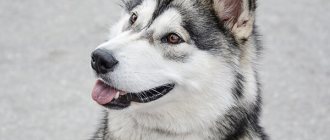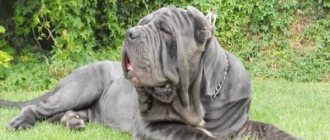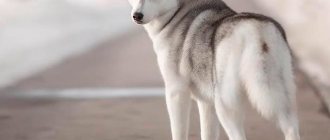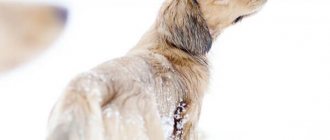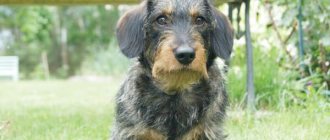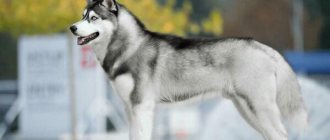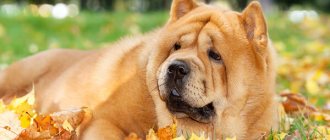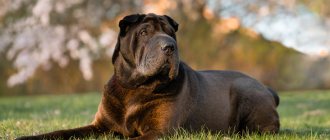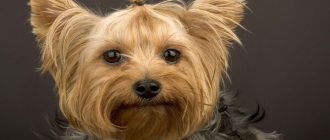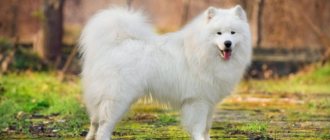The homeland of Siberian huskies is the northeastern part of Siberia.
In these parts there are quite difficult conditions for survival and people were forced to look for not just a companion, but a reliable friend and helper.
This is how the husky appeared. It is believed that the ancestors of this breed were wolves and northern wild dogs.
The dog's height is 50-60 cm, weight is 18-28 kg, life expectancy is 12-15 years.
What does an adult husky look like?
The Siberian Husky is one of the most beautiful and unpretentious dog breeds. The dog is distinguished by its ease of gait, speed and unusual almond-shaped eyes.
As for the body, it can be called moderately compact and quite strong. The dog has a medium-sized head, a strong loin and a slightly sloping croup. Adult huskies have powerful and strong paws, as well as developed muscles, which allows the dog to move quickly and gracefully.
In general, the dog makes a rather harmonious impression, due to the fact that the limbs, head, muzzle and neck have a proportionally correct relationship. The tail of Siberians is fluffy, slightly similar to a fox’s, in an excited state it is raised up, in a calm state it is lowered. The ears are erect, high-set, triangular in shape.
It’s worth mentioning separately about the pet’s eyes; they can be blue or brown in color; heterochromic eyes (different colors) are also allowed by the breed standard. Moreover, their shape in this breed is almond-shaped, and their location is slightly slanting.
The coat of such pets is of medium length, very thick, soft with a dense undercoat. The color palette can vary from snow-white to black.
NOTE!
The husky's calling card is a special mask on its face, which has a unique pattern that is unusual for representatives of other breeds.
Key points in training
- Alaskan Klee Kais need to be introduced to obedience training from an early age. You can do this in group training. Dogs have a reputation for being independent thinkers and not always obedient.
- Mini-huskies are very active and agile animals, so they are perfect for agility classes and coursing.
- Representatives of the breed understand human body language very well, as well as facial expressions. Therefore, in order to correct the behavior of an Alaskan Klee Kai during training, you just need to change your facial expressions or make a movement with your hand. The animal will quickly and without words understand that the owner does not approve of its behavior.
Read about how to properly train a dog in the article: “Training a puppy: effective methods from dog handlers, learning commands at home.”
Breed standard
According to international breed standards, purebred huskies must meet the following requirements:
- The dog's head should be proportional to the body, the muzzle should be of medium width, and the lips should be thin (not loose).
- The eyes of this breed are almond-shaped, set slightly slanted and moderately wide. According to the standard, heterochropromia of the eyes (different colors of the irises) is allowed.
- The pet's ears are medium-sized, triangular and high-set.
- The chest is powerful, but not too wide.
- The neck is curved and raised.
- Paws (front and rear) are straight, parallel, slightly spaced apart.
- The tail is bushy, set just below the top line of the back, in an excited state it is curled up in the shape of a sickle, and in a resting state it is dropped down.
- This pet's coat is short, but very thick, and the undercoat is dense and soft.
Character traits
Siberian Huskies are considered quite intelligent and sociable animals, they are especially attached to children, they are excellent nannies and friends of children.
Some even believe that such a dog does not need special training; simple interest is enough for him.
At the same time, huskies are so friendly that they calmly accept even completely strangers and animals. But at the same time, they can be wayward and stubborn; they simply need a strong leader.
In addition, the dog requires daily physical activity, as its activity is simply off the charts.
IMPORTANT!
The Siberian Husky is a breed that will never become a watchman or guard, due to its natural friendliness. At the same time, violent induction of aggression can lead to mental disorders.
Breeds that are often confused with Husky
The breeds most often called husky varieties are:
- Sakhalin Laika.
- Klee-kai.
- Malamute et al.
In fact, these are amateur breeds with their own history and standards.
Sakhalin Laikas
Sakhalin huskies are a very rare and ancient breed of dog. Their homeland is Sakhalin Island. These are dogs with a very powerful and large body, an elongated body and a strong skeletal system.
As for the differences between the Sakhalin husky and the husky, they are very significant. Firstly, this is the exterior. Secondly, huskies are more suitable for hunting, while huskies are more suitable for sledding. In addition, Sakhalin huskies can bark from time to time like an ordinary dog, but huskies practically do not do this to express emotions; they howl like wolves.
Klee Kai
Other names for this breed are mini-husky or toy husky, its homeland is the USA, the time of appearance of the breed is the 1970s.
Klee Kai are small, playful and very beautiful dogs, similar in appearance to huskies, but smaller in size. The height of such a pet is 33-35 cm, weight -7-8 kg, but there are also smaller varieties. This dog is very friendly, so it is most often kept in an apartment as a pet or a companion for children.
Alaskan Malamute
The Alaskan Malamute's closest relatives are the German Shepherd, Northern Husky and Border Collie. Outwardly, such a dog is a cross between a Siberian husky and a husky.
The coat of such a dog is short, but thick and dense; the hair is almond-shaped and has a blue or brown tint. Life expectancy is 12 -15 years.
By nature, Malamutes are loyal, gentle and affectionate; they are especially kind to children and play with them with pleasure. In addition, dogs are very active, mobile and require long walks and active games.
Proper education is the key to success
Huskies need to be trained from the first months. For example, the love of freedom of puppies leads to frequent escapes and, if the dog is not taught the appropriate command in time, you will have to constantly keep it on a leash. Call your baby to you, and as a reward for a successfully completed command, you can feed him dog delicacies.
Huskies need to be trained from the first months
With such hyperactivity, raising a husky puppy is not an easy task. It is important to accustom a growing pet to various stimuli that the urban environment is so rich in. The noise of cars, the screams of the crowd, the hum of the subway, other dogs - all this at first will be a kind of test for the dog. Walk him in different places - this will speed up the socialization process.
A common mistake that deserves special consideration is punishment for “wrong” actions. This method is especially harmful if you do not catch the dog damaging furniture, relieving itself in the wrong place, or running away. Use the reverse method of “reward” to reinforce positive qualities without reacting in any way to negative experiences. Husky training goes faster than you think, because they are one of the smartest dogs in the world.
The optimal basis for raising a husky is cognitive and educational games, which are carried out on special grounds or at home. With their help, you will establish communication with the dog and become the “leader of the pack.”
Training a husky puppy is also a scrupulous matter, and it must be done from the first months of life. By prohibiting or allowing the dog something, you form a certain pattern of behavior. This is especially necessary at home, when the husky has no contact with its relatives. Don't encourage your dog to beg, be lazy, or commit petty mischief, and you won't have to regret it when it grows up.
Photos and descriptions of colors
This breed has a wide variety of colors, with some colors considered basic, while others are rare. Some colors are found only in working or riding lines of the breed and are not found in show representatives.
The most common types of colors:
- Black . In its pure form it is very rare and can be interspersed with small light areas of fur on the paws, tip of the tail and muzzle. However, for a pet to be considered black, at least 75% of its body must be black.
- Absolutely white is also considered a very rare color. It is characterized by a completely white coat and the same undercoat. The color of the nose can be black, brown or flesh-colored.
- Black and white . In this case, the percentage of colors will be 50/50. From above, the dog is torn by a solid black stripe, covering the back, the top of the head and part of the tail. There is a white stripe below, while the paws are always white and have reddish areas on the folds.
- Silver color allows the presence of only gray colors, while all warm shades are absent here. The color of the undercoat can vary from white to silver.
- Grey . With this color, the coat color will be black, and the undercoat color will be silver with beige shades.
- Copper or chocolate color . It is characterized by rich copper and dark red colors of the coat and undercoat, and the presence of white and cream colors is also acceptable.
Smooth-haired and long-haired
If we talk about the smooth-haired husky, then its coat can be called double, well-haired, thick, but not long. It does not hide the dog's silhouette, has a soft, dense undercoat and straight guard hair.
During the molting period, the undercoat may be absent and this is the norm. A long, coarse or shaggy coat is a fault and will result in a lower score in the show.
As for long-haired huskies, their hair is slightly longer than that of smooth-haired representatives of the breed. At the same time, it is not inferior in softness and thickness. Along the back line of such pets there is a stripe of longer hair than on other parts of the body. As for the colors, they fully correspond to this breed, as does the physique.
NOTE!
According to international standards, heavily fluffy huskies are considered not purebred and are not allowed for exhibitions.
Origin story
Even in ancient times, sled dogs were bred in what is now the Far East. The active development of the direction in its modern form began in the seventeenth century, when the need for transport increased. New, roomy sleighs and sleds appeared, and even more dogs were needed for them.
In 1908, Siberian dogs came to North America, because the Gold Rush in Alaska had just begun. In the USA, the breed was recognized even earlier than at the international level - in 1934. Even the specific names of the breeders who were at the origins of the formation of the standard are known - William Husak, Foke Maul Ramsey and Olaf Svenson.
The very concept of “husky” is a corruption of “Eski” or Eskimo. Now all representatives of the breed are divided into three groups - sledding, working and exhibition. They differ slightly in appearance, but basically it all depends on the opinion of a particular expert.
Photo: irobot-tbk.ru
Do these dogs need to be groomed?
According to experienced dog breeders, it is not advisable to cut your Husky's hair, with the exception of light hygienic trimming, in which the trimmed dog simply takes on a more well-groomed appearance - regrown hairs are removed between the toes, around the anus and genitals, as well as in the ear area. This treatment is done for hygienic purposes and should not affect the appearance of the dog.
Another reason why it is not recommended to cut huskies is a violation of heat exchange, because thick hair warms the dog in winter, and saves it from the heat in summer.
A properly trimmed Husky looks neat without altering its natural contours.
Mating
Since the history of the Alaskan Klee Kai breed is short, its development is closely monitored by breeders and international cynological organizations. Breeding breeding dogs is recommended and permitted only with the consent of regulatory authorities. Owners who do not comply with this requirement are forced to sterilize their animals.
Before mating, all mini-huskies must be checked for genetic problems and diseases of the thyroid gland, heart, patella, and also treated for helminths.
It is recommended to carry out the first mating at the onset of the third heat. Before this procedure, it is advisable to choose and invite a mating specialist. The litter of miniature huskies is small. Most often, there are 1 – 3 puppies in one litter.
Are boys different from girls?
Sexual dimorphism in this breed is quite pronounced - a male, as a rule, is more powerful, stronger and stronger than a girl. In addition, it always has a more elegant color and looks more impressive.
But it would be wrong to say that girls of this breed look pale and homely. At the same time, knots are always smaller in size and have a slightly lighter frame. However, they are not fragile and delicate, since such individuals were cut off by centuries-old selection in the north.
As for exhibitions, males usually make a stronger impression due to their representativeness and brightness of color.
What do the puppies look like?
In the 1st month of life, husky puppies go through 2 most important periods of their lives.
The first 2 weeks are considered the neonatal period. At this time, babies are almost completely helpless and are dense lumps, unable to see, hear, empty themselves and warm themselves. The mother performs all these functions for them.
Starting from the 3rd week, puppies enter a transition period. At this time, their eyes are already open, hearing and interest in the world around them appear.
By the end of the first month, the baby already has milk teeth and begins to taste solid food. At the same time, the puppy continues to feed on mother's milk.
From the 2nd to the 3rd month of life, the dog actively gets acquainted with the world around him, he is curious, sociable and affectionate. This time is also considered a period of early training.
It is during this period that boys experience the descent of the testes into the scrotum. If this does not happen or only one testicle has descended, then you should consult a veterinarian. Often the reason for non-descent of the testes can be stress or emotional overload, since puppies are especially vulnerable at this age.
At the 3rd month of life, the puppy’s weight increases approximately 3 times, and the height at the withers increases by 2 times. At the same time, active growth of tubular bones, chest and skeleton continues. At the same age, puppies begin to establish a hierarchy and the owner’s task is to show the baby who is boss in the family. Also at this time, baby teeth begin to change to permanent ones.
At the 4th month of life, the baby’s growth and development stabilizes and gradually slows down; the puppy enters a period of independence. He also experiences the appearance of his first sexual instincts, which often manifests itself in jumping on fellow tribesmen or on the owner’s leg.
5-6 months – period of independence. The puppy can become very willful, which results in ignoring commands or defiant behavior. At the same time, the eruption of permanent teeth is completed, so the dog has a constant need to chew something. This age is the best period to attend obedience courses.
The age of 6-8 months is another growth spurt, as well as a period of strong fears. During this time, the dog may behave a little strangely, for example, it may be afraid to approach something or refuse to do something that it did before. Outwardly, at this age, the puppy becomes similar to an adult dog.
From 8 to 12 months, a husky is considered a sexually mature young dog. By this moment, all senses have already been formed and the puppy’s perception of the world around him is comparable to the perception of an adult dog.
Ailments
Puppies of this breed are characterized by various ailments, both funny and unpleasant.
Why does he hiccup frequently?
Puppies may hiccup frequently for a variety of reasons. If the hiccups are short-lived, then most likely the pet is thirsty after a vigorous game, or he filled his stomach too quickly, or the dry food was too dry. In any case, you need to give your pet something to drink.
REFERENCE. Before feeding the puppy, it is better to soak the dry food in water.
Hiccups can also be caused by a foreign body stuck in the stomach. If your puppy is prone to frequent bouts of hiccups, you should contact your veterinarian.
Breathes quickly
If the puppy, being in a static position, has rapid breathing, then most likely he is sleeping. The fact is that sleeping dogs, when their sleep reaches the rapid phase, tend to dream. In these dreams, they can experience the same emotions as in real life, and rapid breathing is proof of this.
But if your pet breathes more often than 10-30 breaths per minute while awake, this is a reason to show it to the veterinarian. Since this is already a symptom of respiratory disease.
Diarrhea
If diarrhea is not accompanied by vomiting, fever, dizziness and drowsiness, it is necessary to change the puppy’s diet. In cases where all the symptoms are together, the only vital decision is to take the dog to the veterinarian.
Dandruff
One of the reasons for the appearance of dandruff may be the presence of parasites in the puppy, such as worms and hair mites. Regular deworming will help get rid of them. If your pet does not have any of these, then there is a lack of vitamin A. High-quality food, shampoo and vitamin supplements will correct the skin condition. In a situation where a vitamin-enhanced diet does not produce results, you should think about skin fungus. In this case, only a veterinarian can get rid of the disease.
How to choose your future pet?
Before deciding on a puppy, you need to do the following:
- Inspect several kennels, compare prices and conditions for keeping dogs.
- Examine the entire litter at the age of 1-1.5 months and compare the puppies. It is at this age that the dog’s character and temperament, as well as its behavioral skills, manifest themselves.
- Pay attention to the puppy's health condition. A healthy baby should be moderately well-fed, active, and well-groomed. In addition, he must have a good appetite and a healthy interest in the outside world.
- You must definitely ask the owner of the kennel to show the documents of the parents, as well as the puppies themselves.
You can pick up your baby at the age of 1.5-2 months; it is during this period that puppies are already quite independent and easily adapt to new conditions.
IMPORTANT!
Despite the fact that this breed is suitable for keeping in an apartment, it is not recommended to leave the dog alone at home for a long time. Otherwise, the pet may get bored and start acting up. In addition, loneliness makes the husky too independent and disobedient.
To what age do Hasyats grow?
Until six months of age, Khasenys usually grow at the same pace. And at six months, huskies of different sexes already begin to grow differently. So, girls actively develop and grow in height up to eight months, and then continue to gradually grow up to one year. The weight continues to increase until two years, until the dog finally becomes fully formed. At two years of age, the Husky's growth period finally ends. When a female comes into her first heat, she may grow a little slower. However, this is a temporary condition.
Males grow a little longer than females. Their active development and growth continues for up to nine months. The final growth of the dog is formed by one and a half years. A male husky becomes an adult, fully formed dog only at two or three years of age.
